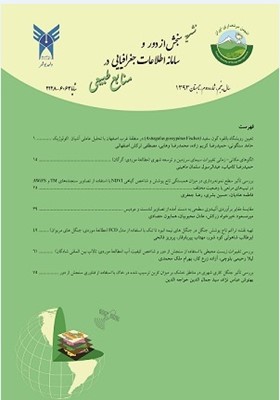بررسی تأثیر سطح نمونهبرداری در میزان همبستگی تاج پوشش و شاخص گیاهی NDVI با استفاده از تصاویر سنجندههای TM و AWiFS در تیپهای مرتعی با وضعیت مختلف
محورهای موضوعی : توسعه سیستم های مکانیفاطمه هادیان 1 * , حسین بشری 2 , رضا جعفری 3
1 - دانش آموخته کارشناسی ارشد مرتع داری، دانشکده منابع طبیعی، دانشگاه صنعتی اصفهان
2 - استادیار دانشکده منابع طبیعی، دانشگاه صنعتی اصفهان
3 - استادیار دانشکده منابع طبیعی، دانشگاه صنعتی اصفهان
کلید واژه: Vegetation index, Semirom, شاخص گیاهی, سطح نمونهبرداری, روش قدم- نقطه, سمیرم, Sampling sizes, Step-point method,
چکیده مقاله :
انتخاب سطح نمونهبرداری مناسب در مطالعات ارزیابی عرصههای وسیع طبیعی به روش های زمینی و سنجش از دوری جهت حصول دقت و صحت مناسب از اهمیت ویژه ای برخوردار است. این مطالعه با هدف بررسی تأثیر سطح نمونهبرداری زمینی در میزان همبستگی تاج پوشش گیاهی با دادههای شاخص گیاهی NDVI حاصل از تصاویر ماهواره ای Landsat5 (سنجنده TM) و IRS-P6 (سنجنده AWiFS) مربوط به زمان نمونهبرداری در مطالعه 3 تیپ مرتعی در شهرستان سمیرم واقع در استان اصفهان انجام شد. در این تحقیق در هر تیپ گیاهی دادههای درصد تاج پوشش گیاهی و سایر اجزای غیر زنده زمین با استفاده از روش قدم- نقطه در 4 ترانسکت با شعاعهای 30، 50، 100 و 150 متری در 10 نقطه تصادفی (به ترتیب در سطوح نمونه برداری 2826، 7850، 31400، 70650 مترمربعی) و تعداد 1200،2000، 4000، 6000 نقطه در هر تیپ گیاهی اندازه گیری گردید. نتایج نشان داد که تصویر سنجنده TM در کلیه سطوح نمونهبرداری همبستگی بهتری را نسبت به تصویر سنجنده AWiFS در بررسی تاج پوشش گیاهی نشان می دهد. در تیپ های گیاهی مورد مطالعه با افزایش میزان تخریب و ناهمگنی پوشش گیاهی، میزان همبستگی تاج پوشش گیاهی و شاخص گیاهی NDVI کاهش مییابد به طوری که در تیپ گیاهی Astragalus spp-Scariola orientalis این همبستگی با استفاده از تصویر سنجنده AWiFS در سطح 5 درصد در هیچ یک از سطوح نمونهبرداری معنی دار نبود اما در تیپ گیاهی Bromus tomentellus به دلیل شرایط یکنواختتر پوشش گیاهی و وضعیت خاکی، بالاترین میزان همبستگی (77%) در سطح نمونهبرداری 7850 متری به دست آمد.
Selecting an appropriate sample size is quite important to achieve acceptable accuracy in evaluating vast natural areas with field and remote sensing methods. This study aimed to evaluate the effect of different sample sizes on the correlation of vegetation cover and remote sensing based indices such as NDVI in three rangeland types, Semirom-Isfahan. Landsat5 (TM sensor) and IRS-P6 (AWiFS sensor) satellite images were used to conduct this research. The percentage of vegetation and ground cover components including canopy cover, litter, rock, gravel, stone and bare soil were determined using step-point method in 4 radial direction in 30, 50, 100 and 150 meters (1200, 2000, 4000 and 6000 points per rangeland type). In other words, the ground cover and NDVI indices correlations were compared in 2826, 7850, 31400 and 70650 square meters using the satellite images. NDVI indices were calculated in all vegetation types and correlated with different components of ground cover. According to results, TM sensor data had more appropriate correlation than AWiFS sensor with field vegetation cover in all studied sample sizes. Vegetation cover and NDVI correlations were decreased in degraded vegetation types with increasing ground heterogeneity. For example, the correlation was not significant (p<0.05) in all studied sample sizes in degraded Astragalus spp-Scariola orientalis vegetation type, while the highest correlation was obtained (77%) in 7850 square meters sample size in more homogeneous Bromus tomentellus vegetation type.

